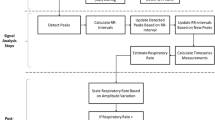Abstract
Motion artefact is a common occurrence that contaminates photoplethysmographic (PPG) measurements. To extract timing information from signals during artefact is challenging. PPG signal is very sensitive to artefacts and can be used in applications like, pulse transit time (PTT) as part of the polysomnographic studies. A correlation cancellation or signal processing approach is implemented with the adaptive cancelling filter concept and a triaxial accelerometry. PPG signals obtained from a Masimo (Reference) pulse oximeter is used as reference to compare with the reconstructed PPG signals. Different hands are used for each PPG source, one stationary while the other involves typical movements during sleep. A second Masimo pulse oximeter is used to register intensity of timing errors on commercial PPG signals. 108 PTT measurements are recorded in three different movements with PTT estimates from unprocessed PPG signals showing 35.51±27.42%, Masimo 50.02±29.40% and reconstructed 4.32±3.59% difference against those from the Reference PPG. The triaxial accelerometry can be used to detect the presence of artefact on PPG signals. This is useful in PTT measurements when signal contaminated with artefacts are required for further analysis, especially after and during arousals in sleep. The suggested filtering model can then reconstruct these corrupted PPG signals.
Similar content being viewed by others
Reference
Smith, R. P, Argod, J., Pepin, J. L. and Levy, P. A.,Pulse Transit Time: An Appraisal of Potential Clinical Applications, Thorax, Vol. 54, No. 5, pp. 452–458, 1999.
Pitson, D. J. and Stradling, J. R.,Value of Beat-to-Beat Blood Pressure Changes, Detected by Pulse Transit Time, in the Management of the Obstructive Sleep Apnoea/Hypopnoea Syndrome, European Respiratory Journal, Vol. 12, No. 3, pp. 685–692, 1998.
Argod, J., Pepin, J. L and Levy, P.,Differentiating obstructive and central sleep respiratory events through pulse transit time, American Journal of Respiratory and Critical Care Medicine, Vol. 158, No. 6, pp. 1778–1783, 1998.
Foo, J. Y. A., Wilson, S. J., Williams, G., Harris, M. and Cooper, D.,Use of Pulse Transit Time in Detection of Upper Airway Obstruction in Sleeping Children, Proceedings of World Congress on Medical Physics and Biomedical Engineering, Vol. 4, ISBN 1877040142, Paper No. 2996, 2003.
Foo, J. Y. A., Wilson, S. J., Williams, G., Harris, M. and Cooper, D.,Differentiating Central and Obstructive Apnoeic Events Using Pulse Transit Time in Children, Internal Medicine Journal, Vol. 34, No. 3, Suppl, pp. A27, 2004.
Webster, J. G.,Medical Instrumentation: Application and Design, 3rd Edition, John Wiley & Sons Inc., New York, USA, 1998.
Hayes, M. J. and Smith, P. R.,Artifact Reduction in Photoplethysmography, Applied Optics, Vol. 37, No. 31, pp. 7437–7446, 1998.
Lu, J., Shen, C., Qiu, X. and Xu, B.,Lattice Form Adaptive Infinite Impulse Response Filtering Algorithm for Active Noise Control, Journal of the Acoustical Society of America, Vol. 113, No. 1, pp. 327–335, 2003.
Ott, A. E., Pate, R. R., Trost, S.G., Ward, D. S. and Saunders, R.,The Use of Uniaxial and Triaxial Accelerometers to Measure Children’s ”Free-Play“ Physical Activity, Pediatric Exercise Science, Vol. 12, pp. 360–370, 2000.
Bussmann, J. B., Damen, L. and Stam, H. J.,Analysis and Decomposition of Signals Obtained by Thigh-Fixed Uni-Axial Accelerometry during Normal Walking, Medical & Biological Engineering & Computing, Vol. 38, No. 6, pp. 632–638, 2000.
Philippaerts, R. M., Westerterp, K. R. and Lefevre, J.,Comparison of Two Questionaries with a Tri-Axial Accelerometer to Assess Physical Activity Patterns, International Journal of Sports Medicine, Vol. 22, pp. 34–39, 2001.
Rowlands, A. V., Thomas, P. W., Eston, R. G. and Topping, R.,Validation of the RT3 Triaxial Accelerometer for the Assessment of Physical Activity, Medicine And Science in Sports and Exercise, Vol. 36, No. 3, pp. 518–524, 2004.
Mansfield, A. and Lyons, G, M.,The Use of Accelerometry to Detect Heel Contact Events for Use as a Sensor in FES Assisted Walking, Medical Engineering & Physics, Vol. 25, No. 10, pp. 879–885, 2003.
Widrow, B., Glover, J. R., McCool, J. M., Kaunitz, J., Williams, C, S., Hearn, R. H., Zeidler, J. R., Dong, E. and Goodlin, R. C.,Adaptive Noise Cancelling: Principles and Applications, Proceedings of the IEEE, Vol. 63, No. 12, pp. 1692–1716, 1975.
Haykin, S.,Adaptive Filter Theory, 2nd Edition, Prentice-Hall Inc., Englewood Cliffs, New Jersey, USA, 1991.
Kepski, R., Buchner, T., Cytowski, J., Malecka, L. and Walczak, F.,Adaptive Filtering in Exercise High Resolution ECG as Applied to the Hypertrophic Cardiomyopathy, Journal of Pacing and Clinical Electrophysiology, Vol. 24, pp. 1216–1223, 2001.
Babchenko, A., Davidson, E., Adler, D., Ginosar, Y., Kurz, V. and Nitzan, M.,Increase in pulse transit time to the foot after epidural anaesthesia treatment, Medical & Biological Engineering & Computing, Vol. 38, No. 6, pp. 674–679, 2000.
Author information
Authors and Affiliations
Corresponding author
Rights and permissions
About this article
Cite this article
Foo, J.Y.A., Wilson, S.J., Williams, G.R. et al. Motion artefact reduction of the photoplethysmographic signal in pulse transit time measurement. Australas Phys Eng Sci Med 27, 165–173 (2004). https://doi.org/10.1007/BF03178645
Received:
Accepted:
Issue Date:
DOI: https://doi.org/10.1007/BF03178645




